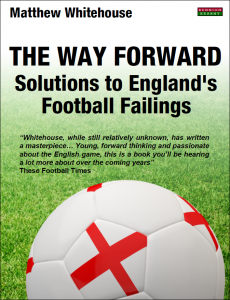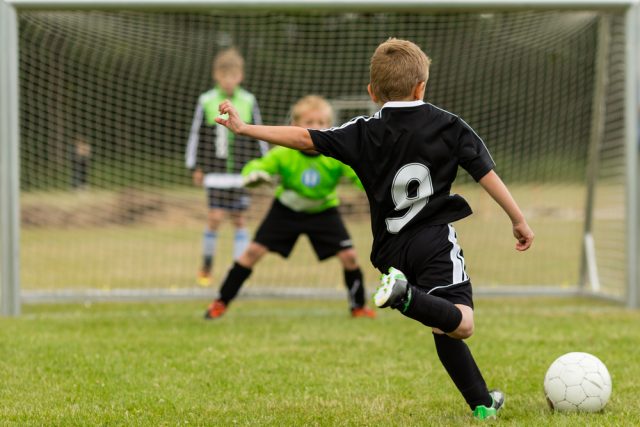Taken from the Matthew Whitehouse bestseller:

![]() Click on the cover to learn more
Click on the cover to learn more
*
“Early specialization is a phenomenon created by self-interested and financially motivated adults” Mike Boyle.
In the past few chapters we have looked at the golden age of learning, issues with the technical development of young players, and concerns about grassroots football. So far we have focused centrally on football yet, as this chapter will discuss, football is not the only sport a young player needs if they wish to become an elite player. It is not just ‘football skills’ which young players need to develop – learning different ‘physical movements’ is even more important.
In turn, it has been found that too much football may be detrimental to the future development of young players. Developing fully rounded players may require less football and more of something else.
It is the all-round development of young children which is essential for developing footballers for the future.
The dangers of pre-academies
In the world of football academies, where each professional club is desperately searching for that ‘special’ player, the needs of the player and child are often overlooked in favour of the future benefits of the academy. Because of the poor quality of grassroots football, professional academies started to develop their own ‘pre-academy’ centres. The argument behind this is similar to what was discussed before: allowing players to work with more educated coaches enables more players to be developed. In theory this sounds like a good idea and yet we have a problem.
Firstly the level of the coaching is not that much better when compared to the volunteer coaches we came across in the last chapter. These coaches are often young lads who possess a level one qualification like their grassroots counterparts. Perhaps their advantage is their ability to perform the skills which they wish the players to perform. However, a lack of knowledge regarding young player development is often evident once again. Furthermore, these ‘pre-academies’ are failing to understand the needs of the young players they are ruthlessly recruiting.
Academies are using the ‘failure’ of grassroots football as an excuse to recruit ‘talented’ players at a younger age than the academy rules allow. The Charter for Quality allowed clubs to sign players from the age of nine, understanding that taking players any younger would not make sense.
Academies created a loophole through ‘pre-academies’ which allow them to recruit individuals under the age of nine.
The question is: why do they do it? For all the talk of ‘developing’ players there is a selfish mentality to these pre-academies and the intention of many is to make sure that they don’t lose a player to another academy.
Although it is near impossible to know if a young child could be the next Wayne Rooney, the fear of missing out on a new Rooney has forced many pre-academies to recruit players with almost a ‘scatter gun’ approach. They look to bring in as many players as possible and hope to find one or two which stand out.
Yet it makes little sense from a developmental perspective; as Brian Jones, Aston Villa’s academy manager highlights, in Every Boy’s Dream, “Aston Villa spend a fortune looking at boys from six onwards – with the best will in the world I wouldn’t know if a six, seven, eight-year-old is going to play in the Premier League in 10 or 12 years’ time. It’s ludicrous.”
At the heart of all this is the competitiveness between clubs. At Arsenal they have an Under-4 group. Why? Because Chelsea have an Under-5 group.
We have a serious problem here. There is little consideration given towards a player’s welfare or well-being. In the mind of the young player this is a chance to (most often) play for the team they love, with the dream of being a professional. Yet when the club informs a youngster’s parents, a week or two later, that the player is no longer needed, the child is left with a feeling of rejection, which can seriously affect him. Why should this be happening to six or seven-year-olds? It is unnecessary and extremely harmful.
Many coaches express concern at the psychological damage of players being ‘rejected’ by these pre-academies at a young age – especially for confidence and enjoyment. Surely these academies should take more consideration into how they treat young children?
It cannot be in a child’s best interests to be treated as a commodity – picked up and let go with ease.
*
Are you a soccer coach? We have more than 25 titles currently available.
Tommy’s story
To highlight this issue let me tell you of the story of Tommy. Tommy is a six-year-old boy who was spotted at a summer football camp by a scout from a local academy. The scout saw a player who can beat players with skill, speed and who can score goals for fun. He feels that he may have spotted some real potential. Tommy’s parents are contacted and invited to attend the pre-academy sessions at the club. His parents are very pleased because the scout has told them that he thinks their son is one of the best in the area.
A few weeks later another scout, from another club in the area, spots Tommy and invites him to their pre-academy session on another night. Well this isn’t a problem because a young player cannot be signed before they are nine years old and can thus attend as many club sessions as the parents wish for. Tommy’s schedule now consists of football training with these pre-academies, a development centre, and his grassroots team which also involves a game for his team on the weekend. Tommy’s time is effectively taken up solely with football training.
Because of this selfish approach by pre-academies, to make sure they don’t lose Tommy, and his parents’ desire for him to become a ‘star’ player – Tommy is at risk of stunting his development as a footballer and sportsman. Let’s examine why.
If we base Tommy’s schedule on the 10,000 hour rule then we could consider all these ‘hours’ of football hugely beneficial for Tommy’s development. At six years old he is clocking up some serious hours in that quest for the magical 10,000. If it takes ten years or 10,000 hours to reach elite levels then Tommy stands a chance to hit that figure when he reaches 16, giving him a real chance of making it as a pro. Or does it?
Pre-academy coaches will argue that doing more football at a young age gives players like Tommy a ‘head start’ on the rest, because of the increased practice hours. It has been found that engaging in intense, highly focused, practice and competition can allow young athletes to reach higher levels of performance more quickly than athletes who delay specialisation. Yet there is a paradox to this situation. Too much football at a young age is in fact detrimental to the long term development of players.
Early specialisation
The debate around early specialisation is one of the sternest in sport. Specialisation is defined as ‘year-round participation in a single sport, at the exclusion of other sports and activities’. Effectively it involves athletes devoting large amounts of time and effort towards one sport, with a targeted focus on high performance.
It has been found that total early specialisation (like Tommy’s schedule) in sports like football or rugby contributes to ‘early drop out, early burn out and early retirement from training and competition’.
Many researchers and coaches are strong advocates for delayed specialisation.
According to youth sports expert Brooke De Lench there is no hard scientific evidence that playing a single sport before the age of twelve, or participating in a select sports program at an early age, guarantees future success. As she says, “It has not been consistently demonstrated that early intense training is essential for attaining an elite level in all sports”. For De Lench, “Early diversification is more likely to lead to success.”
Researchers such as Craig Duncan have found that the benefits of early specialisation are typically short-lived and before too long, the negative consequences of working on a single discipline at an early age, such as injury, begin to emerge.
According to Duncan, who is the head of human performance at Sydney FC, the research literature shows a “significant relationship between early specialisation and injury.” He believes that while research into the path of a champion has been used extensively to justify early specialisation, the resulting increase in injury that it produces in later teens has a much more damaging effect on many more young performers. As he says, “For every champion that specialised early in football there is 100x the number who were not successful doing exactly the same thing.” He argues that it is these individuals who should be studied and highlighted more.
He has also argues that early specialisation restricts the development of the basic motor skills needed to participate in other sports which can lead to long term injury. How many teenage players do you know who have suffered because of injury issues? Osgood-Schlatter (a knee pain injury brought on by overuse while a young player is going through puberty) for example, is a common ailment which afflicts young footballers.
It has been found that high intensity training before physical maturation increases the risk of injury and can delay physical development. Together, restricted motor skill development and a high potential for injury may limit the athlete’s opportunities for participation in other sports at a later age, both competitively and recreationally, once their career in their main sport is over.
According to De Lench, young athletes who participate in a wide variety of sports tend to have fewer injuries and play longer, thereby maintaining a higher level of physical activity than those who specialise before puberty. As De Lench adds, “Prior to the mid to late teens, most children are simply not physically mature enough to handle the stress that playing the same sport on a year-round or nearly year-round basis places on their bodies.”
In a nutshell, too much sport takes its toll on a child’s growing bones, joints, and muscles. It would appear that the surest path to burnout, or an overuse injury, is to play a sport for season after season.
These issues with early specialisation can be seen in the teenage years of those performers who often did too much at a young age. If these persistent injury problems are a major reason why talented teenage footballers don’t make it to becoming professional then as a nation we must understand the reasons, address them, and minimise problems.
When we consider little Tommy and how much football he is playing are we not concerned that he will be more susceptible to injuries in his teenage years which could seriously affect his chances of becoming a professional player? Will he also be more prone to struggle with the pressure and expectation heaped upon him at such a young age? As we shall see in the next section it would have been better for him to take part in a multitude of sports in his early years.
A wide variety
In recent years German football club Borussia Dortmund have enjoyed something of a resurgence in German football. And they have done so by building their success on developing young players. Effectively the club is broke and they realised that in order to achieve anything, developing young players (rather than buying in expensive players) was the answer.
On a visit to Borussia Dortmund’s football academy in 2011 their coaches explained what their ‘secret’ was when developing players. Well, can you guess the first thing they remarked on? It was how ‘young’ the players in English academies are taken in. Their youth co-ordinator could not believe that players as young as five, six and seven were being selected and moved into the academy system (even if it is called pre-academy). They viewed this in the same way that Brian Jones, Brooke De Lench and Craig Duncan view it: too early and detrimental to the long term success of the child.
At Dortmund they begin to take players in at nine years old, yet they believe that between eleven and thirteen is the best time to bring a player into their academy. The reason? Dortmund want fully rounded and developed players and believe that players must have been involved in more than just football in their golden years of learning prior to puberty.
What do I mean by fully rounded players? A study by Fransen et al. (2012) found that boys participating in more than one sport before the age of 12 are more physically fit and have better gross motor coordination than those who specialize in a single sport early on.
The researchers tested a total of 735 boys in three age groups (6-8, 8-10, 10-12) for body mass and height, muscular strength and strength endurance, flexibility, speed and agility, cardiovascular endurance, and gross motor coordination. Boys in the 10-12 year age group who played multiple sports performed significantly better on standing broad jumps and tests of gross motor coordination than boys specializing in a single sport.
Spending many hours per week playing different sports was found to have a positive effect on explosive strength and gross motor coordination across all age groups. Job Fransen, lead author, wrote, “When diversifying early, [those] participating in more than one sport, were exposed to a greater number of physical, cognitive, affective, and psycho-social environments than boys participating in one sport only.”
Early diversification means slower progress in the short term (compared to specialisation) – yet is more beneficial for the long term development of individuals.
Based on the report’s findings, the authors said it was, “Important that children before the age of 12 years [be] encouraged by their coaches, parents, and other training professionals to participate in sports other than just their ‘primary sport’, preferably in combination with many hours per week spent in their sports.” If children are able to experience other sports such as tennis, badminton, basketball, hockey, handball, and climbing, during the key developmental years between 5 and 11 then it appears those children will be much more rounded than those who focus on just one particular sport. And not just those sports, what about gymnastics and dance which can offer greater agility, flexibility and rhythm? All key aspects in football, no?
Physical Literacy
It is clear that there is a need to develop fully rounded players who possess different movements: the ability to run fast, slow, change direction, stop, start, turn and twist. By having young children specialise early we are denying them the opportunity to broaden their movement ‘vocabulary’. It is this idea of motor skills or ‘physical literacy’ as it is known, which is important for long term success in a sport like football.
Key physical movement patterns such as walking, running, jumping, hopping, pushing, pulling, bending, twisting, striking, kicking, throwing and catching are all necessary for a young child to develop their physical literacy. It is an extensive list yet children do all these things if they are given the opportunity and environment to develop and learn.
At Dortmund they require teenage players to have excellent physical literacy; they use the term “multi-lateral” development, which is defined as having an ability to have a range of movements which taking part in only one sport, such as football often fails to provide. Having efficient multi-lateral coordination enables both feet or both hands to work together which allows fluid body movements.
It has been found that taking part in football at a young age produces players with specialised movements, which come about from mastering the specific types of movements from playing one sport.
In their book Periodization, Bompa and Haff argue that, “Multilateral development, or overall physical development, is a necessity… Multilateral development during the athlete’s formative years lays the groundwork for later periods of training when specialization becomes a greater focus of the training plan. If properly implemented, the multilateral training phase will allow the athlete to develop the physiological and psychological basis needed to maximize performance later in his career.”
In turn, training versus age should look something like the following:

We have referred back to the 10,000 hour rule many times in this book, yet what if we consider those hours to incorporate not just football? In the early years of learning, if a child is exposed to a variety of sports and activities then they will have a stronger chance of being more rounded physically, mentally and socially than those who solely take part in football. Yes ‘street soccer’ and futsal are necessary for players to develop their football skills but, as well as this, what young children require is the repetition and practice of non-specific skills. This is essential because the skills used in most sports are really modifications or adaptations of generic fundamental movements. This is where schools play a major role.
A young child who experiences early diversification will improve their physical literacy and increase their chances of long term success.
Schools and their essential role
The physical education curriculum at primary schools is set out to offer broad and balanced athletic provision including games, sports, gymnastics, dance and swimming. Schools are encouraged to offer outdoor pursuits and, importantly, the curriculum is supposed to focus clearly on teaching pupils relevant skills, knowledge and an understanding of physical education. As this section will highlight, many young children in England are being let down by poor standards in primary schools.
When we use the term ‘physical education’ we see that sport in schools is not just playing and being active but, as the title suggests, ‘educational’. When we consider the importance of developing physical literacy it is primary schools which can have the most important role in the development of youngsters. It is here where the foundations for mobility, enthusiasm in sport, and neurological developments are laid.
Research has shown that active lifestyles and taking part in sports improve test scores in other subjects as well as enjoyment levels. Professor Fred Coalter, from the Institute for Sports Research at the University of Stirling, argues that sport contributes to “the promotion and enhancement of education and life-long learning.”
And so it was worrying when an Ofsted inspection in 2013 found that some of the content and nature of P.E. lessons in primary schools across England was, as they reported, ‘concerning’. The chief inspector Sir Michael Wilshaw highlighted how, “There often wasn’t enough physical, strenuous activity in P.E. lessons.”
A previous Ofsted report, which found poor levels of P.E. in schools, led to the creation of the Schools Sports Partnership in 2000. £162m of investment was put in place by the previous Labour government and comprised of 675 core staff that ran England’s 450 school sports partnerships. Beyond that, the £162m also funded 3,200 school sport co-ordinators, one for every secondary school, and 18,000 primary link teachers, one in each primary school. The role of these experts was to inspire pupils to participate in sport and essentially build the core skills for mobility and health. This gave schools specialist P.E. teachers working across primary schools to add capacity and bring high quality, specialist teaching to children.
However, in 2010 the incoming government misunderstood the importance and impact that sport has on the development of not just elite athletes but the influence that sport can have on young people as a whole. The Education Secretary, Michael Gove, decided to cut the £162m annual funding for the Schools Sport Partnership in England and replace it with a £10m investment in Schools Olympics. It was a decision which would, according to Toby Helm and Anushka Asthana in The Guardian, “… threaten most after-school clubs and severely reduce the number of trained P.E. teachers and sports coaches in schools.”
The cuts in school sport prompted more than 70 top British athletes, including Olympic heptathlon champion Denise Lewis and world diving champion Tom Daley, to write to David Cameron to highlight how the policy was “ill-conceived.” Darren Campbell, a British Olympic gold medallist spoke of the importance of P.E. and the damaging impact of the cuts, “I see the positive impact sport is having, not just in P.E., but across the school curriculum. To cut funding now when such incredible results are being achieved is beyond belief.”
The apparent lack of knowledge from those administering P.E. is leading to a reduction in young children developing the necessary physical movements required for long term success in sport.
Baroness Sue Campbell, chairman of the Youth Sport Trust, argued that the cuts had not only affected the contact hours for children taking part in physical education but it had also reduced the quality of teaching. She said it was, “worrying that fewer primary schools are achieving outstanding marks in P.E. From our own research we know that primary school teachers are not receiving adequate training in how to deliver an effective P.E. experience and this can leave teachers lacking the confidence and competence to deliver the subject effectively.”
School sport, particularly in primary school, gives young children a well-rounded physical education which, if done properly, can produce ‘multi-lateral’ developed individuals. Yet if school sport is failing to deliver the quality and education which it sets out to achieve then our young players are being put at a disadvantage before they even arrive at their first football session. If sporting foundations are not built strongly or correctly then it is hard to conceive that our future generations will be adequately prepared to compete with the rest of the world.
Summary
In this chapter the importance of early diversification has been promoted as key for the development of fully rounded individuals. In England, however, there are too many coaches, whether in academies or development centres, who are promoting the early specialisation of young footballers, often for selfish or financial reasons.
Research has shown that specialising early offers short term benefits yet is potentially dangerous in the long term.
Parents need to offer their children more variety at an early age to develop multi-lateral, core physical skills. Alongside this, primary schools need to improve the delivery of physical education in order to improve the development of their pupils’ physical attributes.
The aim of the last few chapters has been to look at the ‘golden years’ of learning of children between 5 and 11 years. As you can see there is much to consider in order to lay the foundations for future success. We are now going to move on to those teenage years where specialisation in football does become more important.



